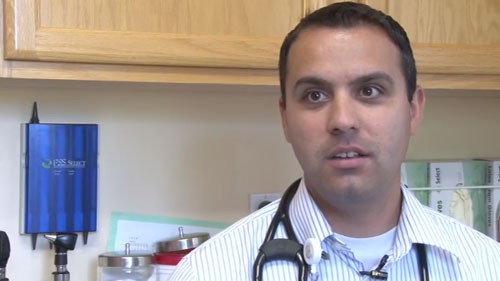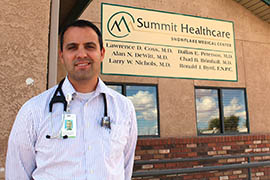Cronkite News has moved to a new home at cronkitenews.azpbs.org. Use this site to search archives from 2011 to May 2015. You can search the new site for current stories.
The rural health care shortage: A new doctor returns to Snowflake
SNOWFLAKE – Dr. Darrell Brimhall knew from age 10 that he wanted to practice medicine in his hometown, but it wasn’t until high school that he realized just how important his role as a doctor would be to this small community.Snowflake has long been burdened with a deficit of doctors to serve its population, which now stands at 5,600. When his brother suffered breathing problems and could only receive special care in the Valley, Brimhall’s mother had to set aside entire days to drive him to doctor’s appointments.
“It was such a huge sacrifice,” he said. “It was over three hours away just one way to make that trip.”
Brimhall later left Snowflake for medical school at the University of Arizona College of Medicine – Phoenix and took part in a program designed to attract doctors to practice in rural and underserved areas. However, he’d already promised that he would be back to help his neighbors.
In July, after completing his residency in Phoenix, he returned.
Brimhall is now juggling a packed schedule as a family practitioner at Summit Healthcare Snowflake Medical Center, where he now sees how his patients deal with limited access to doctors.
Two of his patients, Chan and Lynda Willis, ages 76 and 75, respectively, have lived in Snowflake most of their lives and can attest that things are a little better now.
“There weren’t very many choices until this clinic opened up here,” Lynda said.
Chan added, “I’m very thankful I don’t have to go 60 miles to see a doctor. It’s been a blessing to our area.” listen
The medical center has been in its current location since 2000 and has helped decrease some out-of-town trips, but Brimhall said he’s had to turn people down for appointments because he and the other handful of doctors have a hard time keeping up with the demand.
It’s an issue that the state is all too familiar with. In 1997, the Arizona Legislature created the Rural Health Professions Program to encourage more students like Brimhall to pursue a permanent practice in rural communities where they are needed the most.
The program allows Arizona State University, Northern Arizona University and the University of Arizona students preparing for health care careers to train in these areas up to 12 weeks. For medical students at UA’s downtown Phoenix campus, the requirement was raised recently to 24 weeks.
Dr. Jonathan Cartsonis, director of the program at the University of Arizona in downtown Phoenix, said the added time in these areas will give students a clearer picture of the unique opportunities granted when working in a rural areas, something he said is already becoming apparent with students under the new curriculum.
“We’ve had some really exciting reports back from those students about getting to do things that would really be very unlikely in an urban setting,” he said. “They’re given opportunities by the rural doctors to really integrate into the community, integrate into the medical practice and learn a broad base of skills that they will be able to use later on as they practice medicine.”
Cartsonis said Brimhall’s return to Snowflake is a success story for Arizona.
“We really need to be doing more of this,” he said.
Ana Lyn Roscetti, workforce section manager for the Arizona Department of Health Services, agrees.
The department has its own incentives to attract doctors to practice in underserved areas of Arizona by offering loan repayment. It even has an incentive for foreign doctors to who are training in the state by offering them additional time in the U.S. if they commit to three years of service in these communities.
According to Roscetti, there are 37 federally designated communities in Arizona that are considered medically underserved .
“We have a long way to go,” she said.
Dr. Alan DeWitt, chief medical officer of Summit Healthcare Regional Medical Center in Show Low, was Brimhall’s mentor and used to practice at the same medical center. DeWitt said he recognizes that the doctor shortage is growing and that immersion experiences like the Rural Health Professions Program are critical in rallying new doctors.
“Our greatest recruitment tool for physicians in the community is having the opportunity to have them work with us during their training and experience what it’s like to live here and be a part of the community,” he said.
Brimhall said his desire to return was always rooted with his family, but he added that working alongside the people he’s known all his life is an added bonus that not many doctors can have.
“I know I could live here and work at another place, but I just wanted to live and be among the people that I served,” he said. “That’s why Snowflake was always an option.”










